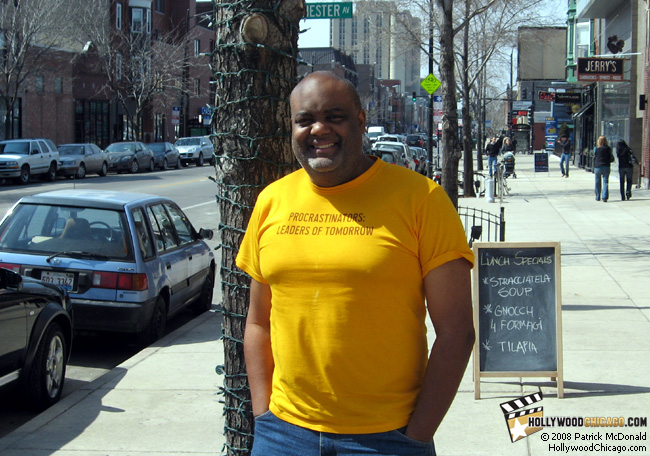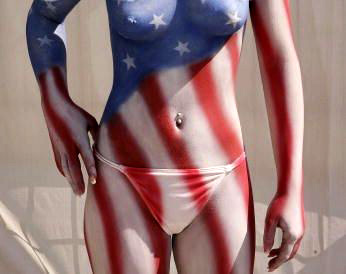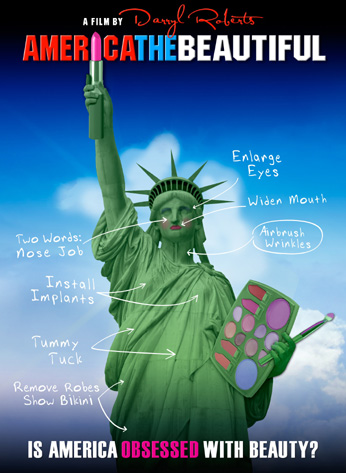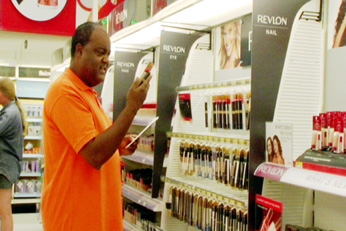CHICAGO – In anticipation of the scariest week of the year, HollywoodChicago.com launches its 2024 Movie Gifts series, which will suggest DVDs and collections for holiday giving.
Chicago Filmmaker Darryl Roberts to Screen ‘America the Beautiful’ at Midwest Independent Film Festival
CHICAGO – Welcome to a new HollywoodChicago.com column called CineOnSceneChicago. “Cine” is a French word derived from “cinematograph,” is pronounced like its connector word “scene” and roughly means “moving picture”. Our goal is to present a moving picture of the Chicago film scene and have fun with it, too. The debut focuses on Chicago filmmaker Darryl Roberts.
Born and raised on the south side of Chicago, his first documentary, “America the Beautiful,” is screening at the Midwest Independent Film Festival on April 1, 2008. We recently caught up with Roberts at a Chicago cafe in Ukrainian Village to better understand “America the Beautiful” and related topics through his eyes.
 Photo credit: Patrick McDonald, HollywoodChicago.com |
HollywoodChicago.com: What’s your film all about? What issues does it cover?
 Darryl Roberts: The film has a lot of different layers. The one issue I wanted to pose before the American culture is that the obsession over the current notion of beauty can’t be good for us. In the “buy this product and you will be beautiful” era, what’s the fallout?
Darryl Roberts: The film has a lot of different layers. The one issue I wanted to pose before the American culture is that the obsession over the current notion of beauty can’t be good for us. In the “buy this product and you will be beautiful” era, what’s the fallout?
We cover the risk of plastic surgery, chemicals in cosmetics and the modeling industry’s contribution to the topic by following one 12-year-old model in her career.
 Photo credit: Darryl Roberts |
HC: She’s 12 years old? How did you come across a 12-year-old model?
 DR: I found Gerren Taylor during Los Angeles Fashion Week. When she came on stage, there was a guy next to me who made it pretty clear he wanted to take her home. That’s when another woman piped in: “You better be careful. She’s only 12 years old.”
DR: I found Gerren Taylor during Los Angeles Fashion Week. When she came on stage, there was a guy next to me who made it pretty clear he wanted to take her home. That’s when another woman piped in: “You better be careful. She’s only 12 years old.”
The presentation of her at that event was true sexualization of a child. I then approached her mother, told her about the documentary and proposed to follow Gerren through the process of her modeling career.
At that time, the documentary was going in many directions. Through following Gerren, I was able to use her story to incorporate the elements of media, fashion and advertising in the entire documentary. I shot her for two years.
I was then able to take all the other nuggets of the film, wrap them around her story and use it all as a narrative thread. It worked perfectly in that context.
HC: After exploring this subject as you have, what issues emerged regarding Americans and beauty especially how it relates to celebrities?
 DR: One of the people I interviewed was Jill Ishkanian. She’s the west coast entertainment editor for US Weekly. She remarked on how happy she was that US Weekly was able to corrupt our society with celebrities because that gets people hooked to her product.
DR: One of the people I interviewed was Jill Ishkanian. She’s the west coast entertainment editor for US Weekly. She remarked on how happy she was that US Weekly was able to corrupt our society with celebrities because that gets people hooked to her product.
She says the average American’s life is very mundane and the more excitement and repetition they generate regarding a beautiful celebrity means the reader will live vicariously through that life and absorb any information they can get about it.
 Image credit: Darryl Roberts |
HC: Were there certain characteristics of “perfect beauty” as you were putting the film together that came up time and time again?
 DR: The terms that would always surface universally were “tall, slim and blonde”. In my research, though, I found only 6 percent of all women are naturally blonde. The rest are dye jobs.
DR: The terms that would always surface universally were “tall, slim and blonde”. In my research, though, I found only 6 percent of all women are naturally blonde. The rest are dye jobs.
There is a real obsession when it comes to the perception of blonde in society. There are statistics, for example, that show singers like Jessica Simpson and Beyoncé quadrupled the album sales of their music when they went blonde.
HC: How does commerce and advertising play a role in beauty?
 DR: Because I interviewed nearly 200 women and only two thought they were beautiful, I wanted to put this statistic in front of the editors of Seventeen, Elle and other advertisers of beauty and ask them how they felt about that.
DR: Because I interviewed nearly 200 women and only two thought they were beautiful, I wanted to put this statistic in front of the editors of Seventeen, Elle and other advertisers of beauty and ask them how they felt about that.
They all – in their own way – rejected their responsibility in the beauty barrage basically because they are in it to make money. They even admit a lot of it is fake with a “buyer beware” warning.
HC: Are women losing value as contributors to society because of this overwhelming, commerce-oriented focus on beauty?
 DR: One of the best interviews in the documentary is with Eve Ensler: the author of “The Vagina Monologues”. She doesn’t read the magazines or watch the commercials because she believes women need to be more proactive about their own self-esteem.
DR: One of the best interviews in the documentary is with Eve Ensler: the author of “The Vagina Monologues”. She doesn’t read the magazines or watch the commercials because she believes women need to be more proactive about their own self-esteem.
While there are many great women doing great things, I do believe when women buy into the concept of who they are is predicated on how they look that society loses a value. There are things these types of women aren’t contributing to because they simply don’t have the confidence.
 Photo credit: Darryl Roberts |
HC: What type of discussion points do you want viewers to take away from your documentary?
 DR: First of all, I want them to ask themselves: “How am I complicit in this beauty game?” Second, I hope they reach out to help the youth – especially teenage girls – build their self-esteem against the wave of more than 2,000 beauty images we all see every day. I call this taking our self-esteem back from advertisers.
DR: First of all, I want them to ask themselves: “How am I complicit in this beauty game?” Second, I hope they reach out to help the youth – especially teenage girls – build their self-esteem against the wave of more than 2,000 beauty images we all see every day. I call this taking our self-esteem back from advertisers.
HC: How did you become interested in filmmaking?
 DR: I studied marketing and accounting in school – no filmmaking – but back in 1986, I was in Los Angeles for the first time. I was driving down Sunset Boulevard, and out of the blue, I turned to my girlfriend at the time and said: “I’m going to make a movie.”
DR: I studied marketing and accounting in school – no filmmaking – but back in 1986, I was in Los Angeles for the first time. I was driving down Sunset Boulevard, and out of the blue, I turned to my girlfriend at the time and said: “I’m going to make a movie.”
I think it came from when I was young and loved John Wayne and Bruce Lee movies along with my desire to emulate them. It seemed my subconscious was always in tune with this ambition. About a year later, I had raised $30,000 and made a romantic comedy called “The Perfect Model”. Like many people before me, though, the journey began on Sunset Boulevard.
Chicago Cine Notes
 The Chicago Tribune on March 25, 2008 ran a “bracketology” article about made-in-Chicago movies with “Ferris Bueller’s Day Off” and “The Blues Brothers” in the final face-off. They missed my favorite “About Last Night” – and a recent dark horse: “The Lake House”.
The Chicago Tribune on March 25, 2008 ran a “bracketology” article about made-in-Chicago movies with “Ferris Bueller’s Day Off” and “The Blues Brothers” in the final face-off. They missed my favorite “About Last Night” – and a recent dark horse: “The Lake House”.
Regardless, between the two I’d go with “The Blues Brothers” only because of the final chase scene through Daley Plaza (plus Ferris seems too much of a California view of Chi-town). Go here to vote on your top pick.
 The Free TV Movie of Week spotlights the old-fashioned local Chicago channels and the films worth seeing that they’re offering. This is for the week of March 31 to April 6, 2008.
The Free TV Movie of Week spotlights the old-fashioned local Chicago channels and the films worth seeing that they’re offering. This is for the week of March 31 to April 6, 2008.
“Animal Farm” (1954) will show on April 6, 2008 at 3 a.m. on Ch. 20 (WYCC). Even though Ch. 20 is the poor-man’s Ch. 11 that often shows bad prints of films, its selections are usually eclectic and unusual. This first animated adaptation of George Orwell’s immortal totalitarianism tale is no exception.
It’s was Britain’s first full-length animated film for entertainment purposes and – get this! – the film rights were obtained by the CIA to create an anti-Communist propaganda message. Orwell’s widow, Sonia, agreed to all this because she got to meet Clark Gable. This alone makes it worth a look or a TiVo. Ch. 20 doesn’t have commercials.
 Ken Candela – The Movie Wag – was a contributor to my blog film reviews. I thought I’d import him here to HollywoodChicago.com. Aside from being a resident film buff, he’s also an expert on the studio system of the early film industry and a movie funnyman. Here is his debut in CineOnSceneChicago where he’s concerned for Owen Wilson’s well-being:
Ken Candela – The Movie Wag – was a contributor to my blog film reviews. I thought I’d import him here to HollywoodChicago.com. Aside from being a resident film buff, he’s also an expert on the studio system of the early film industry and a movie funnyman. Here is his debut in CineOnSceneChicago where he’s concerned for Owen Wilson’s well-being:
After seeing Wilson’s latest film, “Drillbit Taylor,” I suggest that both he and I adjust our medications – his to survive his career and mine to be able to sit through his movies.
 | By PATRICK McDONALD |
| Attachment | Size |
|---|---|
| darryl_roberts.jpg | 150.19 KB |
| atb1.jpg | 23.4 KB |
| atb2.jpg | 45.36 KB |
| atb3.jpg | 68.22 KB |


